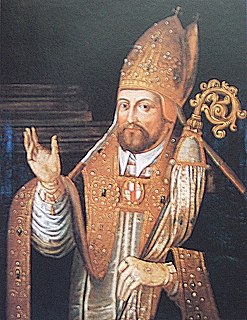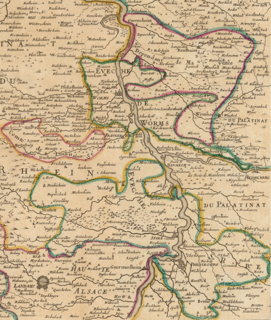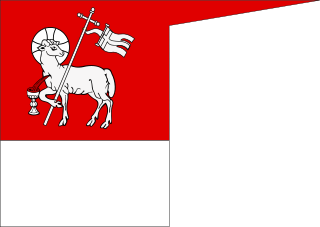
A prince-bishop is a bishop who is also the civil ruler of some secular principality and sovereignty. The principality or prince-bishopric (Hochstift) ruled politically by a prince-bishop could wholly or largely overlap with his diocesan jurisdiction, but some parts of his diocese, even the city of his residence, could be exempt from his civil rule, obtaining the status of free imperial city. If the episcopal see is an archbishop, the correct term is prince-archbishop; the equivalent in the regular (monastic) clergy is prince-abbot. A prince-bishop is usually considered an elected monarch.

The Electorate of Mainz, previously known in English as Mentz and by its French name Mayence, was one of the most prestigious and influential states of the Holy Roman Empire. In the Roman Catholic hierarchy, the Archbishop-Elector of Mainz was also the Primate of Germany, a purely honorary dignity that was unsuccessfully claimed from time to time by other archbishops. There were only two other ecclesiastical Prince-electors in the Empire: the Electorate of Cologne and the Electorate of Trier.

The Prince-Bishopric of Worms, was an ecclesiastical principality of the Holy Roman Empire. Located on both banks of the Rhine around Worms just north of the union of that river with the Neckar, it was largely surrounded by the Electorate of the Palatinate. Worms had been the seat of a bishop from Roman times. From the High Middle Ages on, the prince-bishops' secular jurisdiction no longer included the city of Worms, which was an Imperial Free City and which became officially Protestant during the Reformation. The prince-bishops however retained jurisdiction over the Cathedral of Worms inside the city.
The term coadjutor is a title qualifier indicating that the holder shares the office with another person, with powers equal to the other in all but formal order of precedence.

The Prince-Bishopric of Liège or Principality of Liège was an ecclesiastical principality of the Holy Roman Empire situated for the most part in present-day Belgium. It was an Imperial Estate, so the bishop of Liège, as its prince, had a seat and a vote in the Imperial Diet. The Prince-Bishopric of Liège should not be confused with the Diocese of Liège, which was larger and over which the prince-bishop exercised only the usual responsibilities of a bishop.

The Archdiocese of Bamberg is a diocese of the Roman Catholic Church in Bavaria and is one of 27 Roman Catholic dioceses in Germany. 32.9% of the population in 2015 identified as Catholic, with 15.6% attending Mass on Sunday -- a relatively high number in Germany. The archdiocese comprises the majority of the administrative regions of Upper Franconia and Middle Franconia, as well as a small part of Lower Franconia and the Upper Palatinate. Its seat is Bamberg. The dioceses of Speyer, Eichstätt, and Würzburg are subordinate to it. The Diocese was founded in 1007 out of parts of the dioceses of Eichstätt and Würzburg. In 1817, the diocese was raised to an archdiocese.

Bernardo Clesio was an Italian Cardinal, bishop, diplomat, humanist and botanist.

Cristoforo Madruzzo was an Italian Roman Catholic cardinal and statesman. His brother Eriprando was a mercenary captain who fought in the Italian Wars.

The Diocese of Halberstadt was a Roman Catholic diocese from 804 until 1648. From 1180, the bishops or administrators of Halberstadt ruled a state within the Holy Roman Empire, the prince-bishopric of Halberstadt. The diocesan seat and secular capital was Halberstadt in present-day Saxony-Anhalt.

The Prince-Bishopric of Trent, was an ecclesiastical principality roughly corresponding to the present-day Northern Italian autonomous province of Trentino. It was created in 1027 and existed until 1802, when it was secularised and absorbed into the County of Tyrol held by the House of Habsburg. Trent was a Hochstift, an Imperial State under the authority of a prince-bishop at Trento.

The Prince-Bishopric of Brixen was an ecclesiastical principality of the Holy Roman Empire in the present-day northern Italian province of South Tyrol. It should not be confused with the larger Catholic diocese, over which the prince-bishops exercised only the ecclesiastical authority of an ordinary bishop. The bishopric in the Eisack/Isarco valley was established in the 6th century and gradually received more secular powers. It gained imperial immediacy in 1027 and remained an Imperial Estate until 1803, when it was secularised to Tyrol. The diocese, however, existed until 1964, and is now part of the Diocese of Bolzano-Brixen.

The Prince-Bishopric of Münster was a large ecclesiastical principality in the Holy Roman Empire, located in the northern part of today's North Rhine-Westphalia and western Lower Saxony. From the sixteenth to the eighteenth centuries, it was often held in personal union with one or more of the nearby ecclesiastical principalities of Cologne, Paderborn, Osnabrück, Hildesheim, and Liège.
The Vicariate Apostolic of Northern Germany was known for most of its existence as the Vicariate Apostolic of the NorthernMissions, established on 28 April 1667. It was a Roman Catholic missionary jurisdiction of a Vicar Apostolic in predominantly Protestant Northern Europe. On 7 August 1868, on the occasion of completing separate jurisdictions for all of Scandinavia, the vicariate only continued to comprise small areas in Northern Germany and was thus renamed. With the integration of these areas into other Roman Catholic dioceses the vicariate ceased to exist on 13 August 1930.

The Prince-Bishopric of Osnabrück) was an ecclesiastical principality of the Holy Roman Empire from 1225 until 1803. It should not be confused with the Diocese of Osnabrück, which was larger and over which the prince-bishop exercised only the spiritual authority of an ordinary bishop. It was named after its capital, Osnabrück.

The Prince-Bishopric of Bamberg was an ecclesiastical State of the Holy Roman Empire. It goes back to the Roman Catholic Diocese of Bamberg established at the 1007 synod in Frankfurt, at the behest of King Henry II to further expand the spread of Christianity in the Franconian lands. The bishops obtained the status of Imperial immediacy about 1245 and ruled their estates as Prince-bishops until they were subsumed to the Electorate of Bavaria in the course of the German Mediatisation in 1802.
The Duchy of Tridentum (Trent) was an autonomous Lombard duchy, established by Euin during the Lombard interregnum of 574–584 that followed the assassination of the Lombard leader Alboin. The stronghold of Euin's territory was the Roman city of Tridentum in the upper valley of the Adige, in the foothills of the Alps in northern Italy, where the duchy formed one of the marches of the Lombard Kingdom of Italy. There he shared power with the bishop, who was nominally subject to the Patriarch of Aquileia. In 574–75, Lombard raiding parties pillaged the valley of the Rhône, incurring retaliatory raids into the duchy by Austrasian Franks, who had seized control of the mountain passes leading into the kingdom of Burgundy. Euin was at the head of the army loyal to Authari that went into the territory of the duke of Friuli in Istria, c 589, and he was sent by Agilulf to make peace with the Franks his neighbors, in 591. After Euin's death c 595, Agilulf installed Gaidoald, who was a Catholic, rather than an Arian Christian. After some friction between king and duke, they were reconciled in 600. The separate Lombard duchy of Brescia was united with Tridentum in the person of Alagis, a fervent Arian and opponent of the Lombard king, Perctarit, who was killed in the battle of Cornate d'Adda (688).
Archdiocese of Utrecht or Diocese of Utrecht may refer to:

In the Holy Roman Empire, the German term (das) Hochstift referred to the territory ruled by a bishop as a prince, as opposed to his diocese, generally much larger and over which he exercised only spiritual authority. The terms prince-bishopric and ecclesiastical principality are synonymous with Hochstift. Erzstift and Kurerzstift referred respectively to the territory (prince-archbishopric) ruled by a prince-archbishop and an elector-archbishop while Stift referred to the territory ruled by an imperial abbot or abbess, or a princely abbot or abbess. Stift was also often used to refer to any type of ecclesiastical principality.

The Diocese and Prince-bishopric of Schwerin was a Catholic diocese in Schwerin, Mecklenburg, in Germany. The first registered bishop was ordained in the diocese in 1053, and the diocese ceased to exist in 1994.

The Prince-Bishopric of Warmia was a semi-independent ecclesiastical state, ruled by the incumbent ordinary of the Warmia see and comprising one third of the then diocesan area. The Warmia see was a Prussian diocese under the jurisdiction of the Archbishopric of Riga that was a protectorate of the Monastic state of the Teutonic Knights (1243–1464) and a protectorate and part of the Kingdom of Poland—later part of the Polish–Lithuanian Commonwealth (1464–1772), confirmed by the Peace of Thorn in 1466. The other two thirds of the diocese were under the secular rule of the Teutonic Knights until 1525 and Ducal Prussia thereafter, both entities also being a protectorate and part of Poland from 1466.















